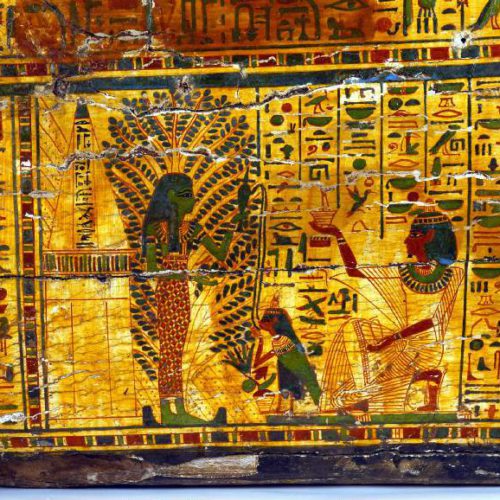Teaching activities: videos, activity ideas and information about objects
The exquisitely decorated coffin set of Nespawershefyt is an example of the skilful craftsmanship that went into making coffins in ancient Egypt. Looking closely at how it is decorated we can observe ancient Egyptian beliefs, daily rituals and how important the afterlife was to people.
- Recent research has shown that Nespawershefyt’s coffin set was made from sections of recycled wood. Can you think why this might be? What kind of climate does Egypt have, is there many large trees?
- If you were Nespawershefyt, how would you feel about your coffin being on display?
- What can we learn about Nespawershefyt’s life by looking at his coffin? Think about the materials and the skills that were needed to make it. What does this tell us about him?
- Nespawershefyt’s coffin was painted with a variety of brushes and pens made from hollow stems and plants – a selection of which you can see in our collection. Try making your own ancient Egyptian paintbrush with this video tutorial.
- This coffin is covered with images from the book of the dead, showing Nespawershefyt’s route to the afterlife. Pick your favourite scene and bring it to life through stop frame animation or a Gif using these tutorials.
- One panel of the coffin shows Nespawershefyt kneeling down and offering his heart to be weighed against goddess Maat’s feather of truth, by Anubis, the jackal headed god of mummification. Can you find it? In groups, recreate this scene as a freeze frame.
- Separate the class into groups: Gods and Goddess, symbols, animals and objects. Set a timer and see how many each group can find – write them up in a tally.
Talking about death, human remains, and the beliefs and rituals concerning end of life can be difficult. Be sensitive to those in your classroom community who have recently experienced any kind of bereavement, or who may feel anxious discussing these topics.
Be prepared by offering alternative activities for those who find this too uncomfortable, but try to make space for those who want to explore and discuss their thoughts and feelings about death as well. Get support for yourself from colleagues or professional organisations if you need it.
At the museum, we try to teach about the people and real lives involved when we show these incredible items to classes. Using objects and artefacts to teach ancient Egypt is a fantastic way to encourage sensitive and ethical attitudes about other people’s cultures and beliefs. It also avoids othering the ancient Egyptian people, or explaining their vast culture in a reductive way.
The culture of Egyptomania across Western Europe and the USA led to some unethical acquisitions of things from ancient Egypt. You might discuss with your class how these artefacts came to reside in museums in England. What do your students think about the fact that so many ancient Egyptian items are so widely dispersed away from the country they were made and used in?
